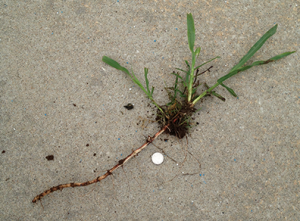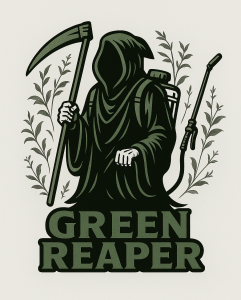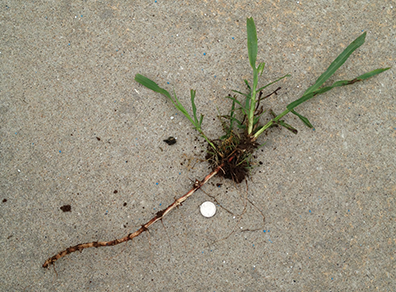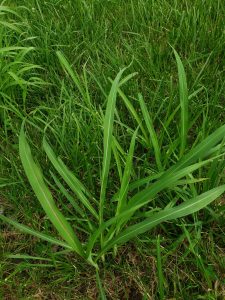Johnsongrass – A Grassy Weed with a Bad Attitude
🗓️ Updated July 2025 – If you’ve got tall, coarse clumps taking over your lawn, odds are good you’re dealing with Johnsongrass. The Goliath of Weeds, but don’t worry! We can help you slay this giant! Here’s what it is, why it’s so stubborn, and what ClassicLawns is doing about it with our Green Reaper Program.
Johnsongrass is one of the most difficult and aggressive grassy weeds we deal with. It stands out in your lawn with thick, fast-growing stalks that tower above your turf like it owns the place. You can mow it down, but it’ll be back in a few days — taller, bolder, and just as annoying.
It’s a perennial weed, meaning it comes back year after year. And because it spreads through rhizomes (underground roots) and seeds, it’s not just surviving — it’s multiplying.
 Why Johnsongrass Is So Hard to Control
Why Johnsongrass Is So Hard to Control
Most grassy weeds are tough, but Johnsongrass is in a class of its own. Here’s why:
- It grows faster and taller than your regular lawn grass, especially fescue.
- It has a thick white vein (midrib) down the center of each blade.
- It spreads underground, so pulling it doesn’t help — in fact, it makes it worse.
- It’s resistant to most of the weed control products used in standard lawn treatments.
This isn’t something we can fix with one blanket spray. Johnsongrass laughs at broadleaf herbicides and shrugs off most general weed control products. That’s why we take a specialized approach.
The Green Reaper Program: Targeted Weed Execution
For lawns with Johnsongrass and other aggressive grassy invaders (Goosegrass, Paspalums, and Dallisgrass), ClassicLawns now offer a specialized treatment program called the Green Reaper.
This is not part of our standard lawn care program — it’s a targeted assault, custom-built for the nastiest weed cases we see.
 Here’s how we handle Johnsongrass under the Green Reaper plan:
Here’s how we handle Johnsongrass under the Green Reaper plan:
- We identify and flag the Johnsongrass areas for direct treatment.
- We use advanced, selective products. Specialty herbicides that are tough on grassy invaders that minimize damage to good turf.
- Treatments are repeated every 3–4 weeks for a total of 3 to 5 treatments depending on severity and lawn conditions.
- These products work slowly, but over time they weaken and suppress the weed — reducing regrowth and limiting spread.
⚠️ Keep in mind: Even with specialty products, Johnsongrass rarely dies after one treatment. Control is a process, not a one-time fix.
We’ll also recommend core aeration and overseeding in the fall to fill in bare areas and improve turf density. A thicker lawn is one of the best defenses against weed invasion.
What Not to Do
You may have heard not to pull Johnsongrass — and that’s mostly true. If it’s fully established, pulling usually just snaps the rhizomes and spreads the problem. You end up with two or three new shoots for every one you yank out.
However, in early stages — especially when the soil is moist and the plant is just emerging — you can sometimes get lucky and pull the whole thing, root and all. If you try this, grip low and pull slow. If it breaks off easily, don’t keep tugging — that usually means you’re just making it mad and multiplying it underground.
So yes, there are a few scenarios where hand-pulling can help, but timing and technique matter. If you’re unsure, it’s best to leave it to us and let the Green Reaper handle it with targeted treatments.
Mowing it short also won’t kill it — it just comes back faster.
What You Can Do
- Let us know where you’re seeing it — flag the area or text us a picture.
- Water properly and mow tall to help surrounding turf outcompete it.
- Be patient — grassy weed control takes time, especially for perennial spreaders like this.
Final Word from Cary:
I’ve been battling Johnsongrass since I started in this business over 30 years ago. It’s one of the most frustrating weeds out there — for homeowners and pros alike. But with the right approach and consistent treatments, ClassicLawns can knock it down and keep it in check.
🌾 Turf Nerd Corner: A Few Interesting Facts About Johnsongrass
- It was introduced on purpose in the 1800s as a forage crop for livestock. Oops.
- It’s on the noxious weed list in several states, including Missouri, because of how invasive it is.
- Under stress, it can become toxic to livestock, producing compounds like cyanogenic glycosides.
- Johnsongrass is considered one of the top 10 worst weeds in the world by the Weed Science Society of America.
- The name came from an Alabama plantation owner, Colonel William Johnson, who first cultivated it. So yes, it was literally Johnson’s grass.


